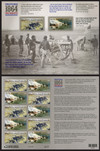
# 4910-11b - 2014 First-Class Forever Stamp - Imperforate The Civil War Sesquicentennial, 1864
U.S. #4910-11b
2014 49¢ Civil War Imperforate
Pair
Â
These stamps are the fourth installment in a series commemorating the 150th anniversary of the Civil War. They picture the 22nd United States Colored Troops at the Battle of Petersburg and Admiral Farragut’s fleet during the Battle of Mobile Bay.
Â
Following his successful siege of Vicksburg and victory at Chattanooga the previous year, Ulysses S. Grant was promoted to general-in-chief of the Union Army in March 1864. In the months that followed, Grant began persistent campaigns against the under-resourced Confederacy.
Â
The Union was poised toward victory and prepared to beat down the enemy. Unlike many commanders, Grant did not pull back after a victory, nor did he retreat after a loss. Throughout 1864, the Union Army relentlessly pursued the Confederates, dealing blow after blow to the South. Casualties were overwhelming on both sides, but Southern losses were irreplaceable. The North suffered tactical defeats but gained an overall strategic advantage as the South’s resources were strained to the brink.
Â
By the end of 1864, General Robert E. Lee was trapped in the Confederate capital of Richmond with supply lines cut off and resources dwindling by the day. Atlanta, Savannah, and Nashville were lost and the last significant Confederate port, Mobile Bay, had been seized by summer’s end. The successes improved Northern morale and President Lincoln was reelected that November. The tide had turned in the Union’s favor and the end of the War Between the States was soon to follow.Â
Â
49¢ Civil War Sesquicentennial, issued to satisfy the first-class mail rate
Issue Date: July 30, 2014
City: Petersburg, VA
Category: Commemorative
Printed By: Banknote Corporation of America for Sennett Security Products
Printing Method: Lithographed in double-sided sheets of 72 with six panes of 12 per sheet
Perforations: Imperforate
Self-adhesive
On July 30, 1864, Union forces launched the surprise Battle of the Crater. They dug tunnels under Confederate positions and set off explosives to catch them by surprise, but poor decisions led the battle to turn against them. The siege of Petersburg continued through the summer of 1864. Both sides reinforced their fortifications and dug more trenches. Lieutenant General Ulysses S. Grant had learned he could not defeat Lee’s men when they were in a defensive position. By June, Grant was open to suggestions, even if they seemed far-fetched. Union Major General Ambrose Burnside’s IX Corps included the 48th Pennsylvania Volunteer Infantry, made up mostly of former coal miners. Under the leadership of Lieutenant Colonel Henry Pleasants, the division proposed digging a tunnel under Elliott’s Salient, the closest point in the Confederate fortifications. Once completed, they would explode the mine, taking the Southern Army by surprise. Burnside presented the plan to Major General Meade and Grant, who both approved it, considering the project a good way to keep the men busy during the siege. The digging began on June 25. Pleasants, a former mining engineer, supervised the round-the-clock shifts. Dirt was removed by the bucketful and on homemade sledges. Wood was taken from a mill and an old bridge to shore up the sides of the 500-foot tunnel. The crew even devised a ventilation system to send fresh air to the workers. Some Confederate soldiers claimed they heard digging beneath them, but General Lee refused to believe the rumors. Once the miners reached the desired length, they branched sideways for 75 feet, forming a T-shape. The tunnel was completed on July 23, and the last section was filled with 8,000 pounds of gunpowder and sealed off. While the volunteers from Pennsylvania were digging, other troops were preparing for the attack. General Burnside trained a division of United States Colored Troops, commanded by Brigadier General Edward Ferrero. They practiced using ladders to exit their trenches and enter the opening quickly. After entering the breach, the men would move along the sides of the crater to secure the area. The Union Army planned to use the devastation and confusion caused by the explosion to take Petersburg. The day before the attack, General Meade made a change of plans. He ordered Burnside to use white troops to lead the attack, instead of the US Colored Troops. Brigadier General James H. Ledlie’s 1st Division was chosen to enter first, but his men were not briefed on the plan. On July 30, the fuse was lit at 3:15 a.m. The miners had been given poor-quality fuses that had to be spliced together. After waiting an hour for the explosion, two volunteers entered the mine, respliced the fuse, relit it, and ran outside. At 4:45, the Confederates were awakened by an eruption of dirt and debris. A crater 170 feet long, 100 feet wide, and about 30 feet deep was created, and over 275 rebel troops were killed immediately. Ledlie’s men hesitated to leave their trenches and took additional time to climb out. When the Union soldiers reached the crater, they took cover in it rather than encircling it as the black soldiers had been trained to do.  By that time, Confederate Major General William Mahone regrouped his men, who aimed their guns and artillery directly into the crowd. Rather than ordering a retreat, Burnside sent Ferrero and his troops into battle. Despite great losses, the Union was able to secure the right side of the crater, but a counterattack pushed them back to their trenches.The Battle of the Crater
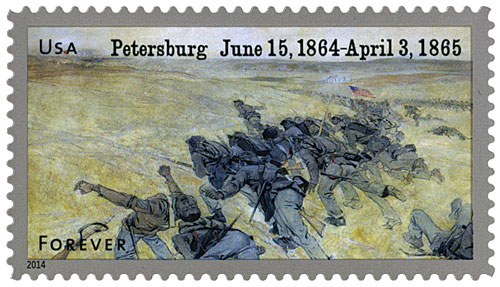
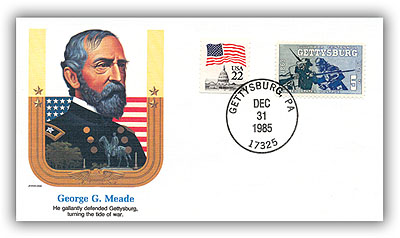
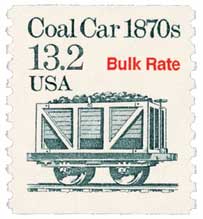
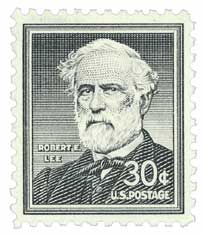
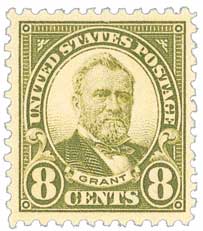
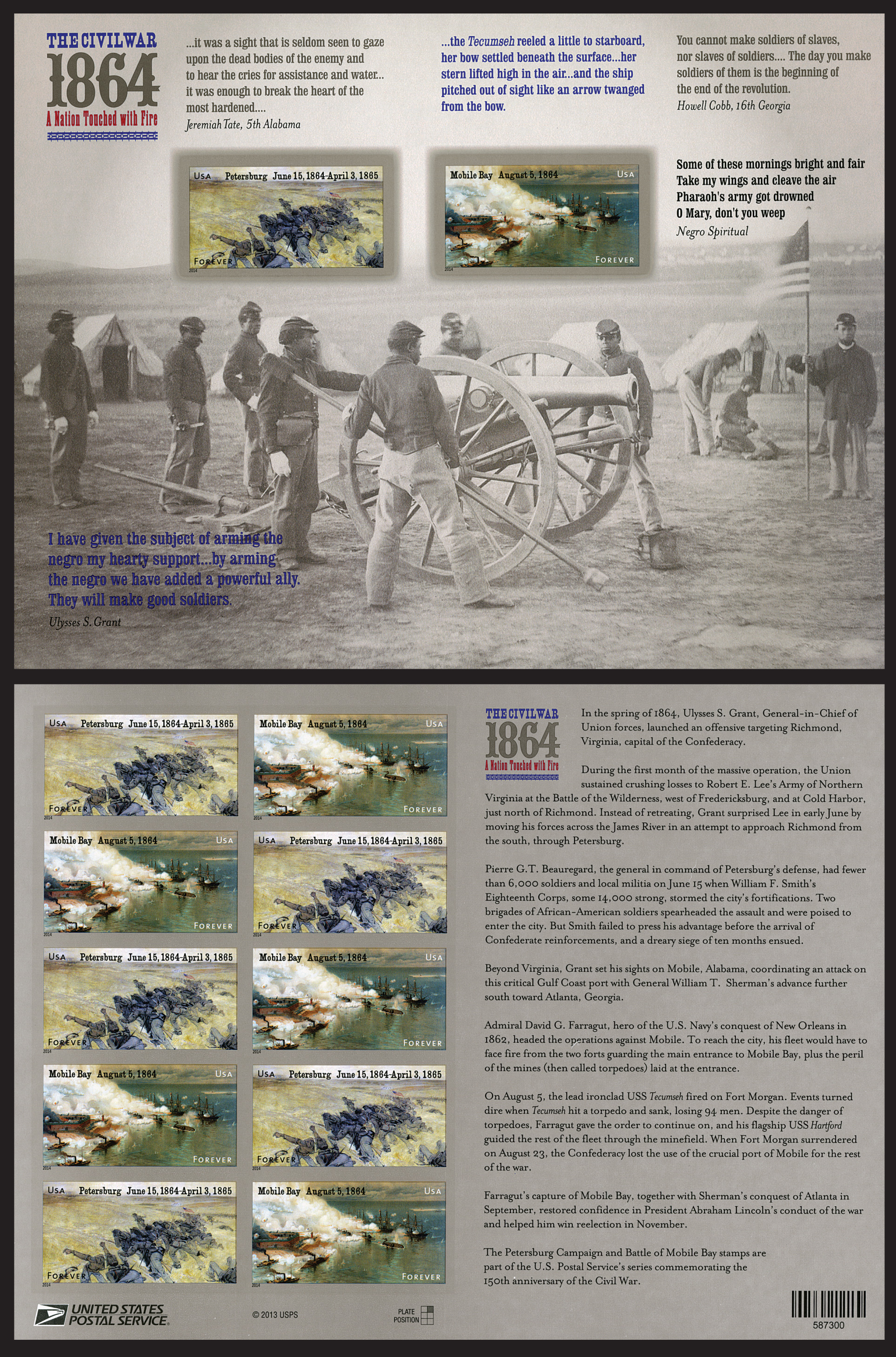
The fighting subsided by early afternoon, and the Union missed an opportunity to end the siege at Petersburg. Ledlie was dismissed because of his poor leadership and reports he was drunk at the time of the battle. Burnside was also removed from command. Mining engineer Pleasants was praised for the concept and construction of the mine. He was later appointed a brevet brigadier general. Mahone’s quick actions and successful counterattack earned him a reputation as one of the Confederacy’s best generals in the final year of the Civil War. The large hole in the ground can still be seen today. It is a testimony to the ingenuity of Pennsylvania miners and tragic loss of life as a result of the Battle of the Crater.Â
Scarce Modern Imperforates
The modern imperforate stamps are one of the hottest stories around. In 2012, the U.S. Postal Service released some issues as press sheets. The sheets with die cut perforations were issued in limited quantities.Â
Â
To the surprise of many collectors, officials then issued a small number of press sheets without perforations. The uncut sheets were only available in Kansas City, Missouri, yet most sold out immediately. In an instant, the imperforate stamp sheets became modern rarities. For example, only 75,000 Baseball All-Star se-tenant sheets were issued compared to 118,000 Bugs Bunny sheets with the 10th stamp imperforate.
Â
In a controversial move, the editors of Scott Catalogue announced they would not list or give numbers to these stamps because they did not fit Scott guidelines. This decision was strongly debated since the imperforate stamps are valid for postage. They eventually decided to give the stamps minor numbers and have continued issuing imperforates in the years since.
Â
Because they were issued in such limited quantities, these scarce modern imperforates can be difficult to find. Luckily Mystic purchased a small number of each imperforate stamp issued so you can add these modern rarities to your collection. Be one of the lucky few – order today.Â
Â
U.S. #4910-11b
2014 49¢ Civil War Imperforate
Pair
Â
These stamps are the fourth installment in a series commemorating the 150th anniversary of the Civil War. They picture the 22nd United States Colored Troops at the Battle of Petersburg and Admiral Farragut’s fleet during the Battle of Mobile Bay.
Â
Following his successful siege of Vicksburg and victory at Chattanooga the previous year, Ulysses S. Grant was promoted to general-in-chief of the Union Army in March 1864. In the months that followed, Grant began persistent campaigns against the under-resourced Confederacy.
Â
The Union was poised toward victory and prepared to beat down the enemy. Unlike many commanders, Grant did not pull back after a victory, nor did he retreat after a loss. Throughout 1864, the Union Army relentlessly pursued the Confederates, dealing blow after blow to the South. Casualties were overwhelming on both sides, but Southern losses were irreplaceable. The North suffered tactical defeats but gained an overall strategic advantage as the South’s resources were strained to the brink.
Â
By the end of 1864, General Robert E. Lee was trapped in the Confederate capital of Richmond with supply lines cut off and resources dwindling by the day. Atlanta, Savannah, and Nashville were lost and the last significant Confederate port, Mobile Bay, had been seized by summer’s end. The successes improved Northern morale and President Lincoln was reelected that November. The tide had turned in the Union’s favor and the end of the War Between the States was soon to follow.Â
Â
49¢ Civil War Sesquicentennial, issued to satisfy the first-class mail rate
Issue Date: July 30, 2014
City: Petersburg, VA
Category: Commemorative
Printed By: Banknote Corporation of America for Sennett Security Products
Printing Method: Lithographed in double-sided sheets of 72 with six panes of 12 per sheet
Perforations: Imperforate
Self-adhesive
On July 30, 1864, Union forces launched the surprise Battle of the Crater. They dug tunnels under Confederate positions and set off explosives to catch them by surprise, but poor decisions led the battle to turn against them. The siege of Petersburg continued through the summer of 1864. Both sides reinforced their fortifications and dug more trenches. Lieutenant General Ulysses S. Grant had learned he could not defeat Lee’s men when they were in a defensive position. By June, Grant was open to suggestions, even if they seemed far-fetched. Union Major General Ambrose Burnside’s IX Corps included the 48th Pennsylvania Volunteer Infantry, made up mostly of former coal miners. Under the leadership of Lieutenant Colonel Henry Pleasants, the division proposed digging a tunnel under Elliott’s Salient, the closest point in the Confederate fortifications. Once completed, they would explode the mine, taking the Southern Army by surprise. Burnside presented the plan to Major General Meade and Grant, who both approved it, considering the project a good way to keep the men busy during the siege. The digging began on June 25. Pleasants, a former mining engineer, supervised the round-the-clock shifts. Dirt was removed by the bucketful and on homemade sledges. Wood was taken from a mill and an old bridge to shore up the sides of the 500-foot tunnel. The crew even devised a ventilation system to send fresh air to the workers. Some Confederate soldiers claimed they heard digging beneath them, but General Lee refused to believe the rumors. Once the miners reached the desired length, they branched sideways for 75 feet, forming a T-shape. The tunnel was completed on July 23, and the last section was filled with 8,000 pounds of gunpowder and sealed off. While the volunteers from Pennsylvania were digging, other troops were preparing for the attack. General Burnside trained a division of United States Colored Troops, commanded by Brigadier General Edward Ferrero. They practiced using ladders to exit their trenches and enter the opening quickly. After entering the breach, the men would move along the sides of the crater to secure the area. The Union Army planned to use the devastation and confusion caused by the explosion to take Petersburg. The day before the attack, General Meade made a change of plans. He ordered Burnside to use white troops to lead the attack, instead of the US Colored Troops. Brigadier General James H. Ledlie’s 1st Division was chosen to enter first, but his men were not briefed on the plan. On July 30, the fuse was lit at 3:15 a.m. The miners had been given poor-quality fuses that had to be spliced together. After waiting an hour for the explosion, two volunteers entered the mine, respliced the fuse, relit it, and ran outside. At 4:45, the Confederates were awakened by an eruption of dirt and debris. A crater 170 feet long, 100 feet wide, and about 30 feet deep was created, and over 275 rebel troops were killed immediately. Ledlie’s men hesitated to leave their trenches and took additional time to climb out. When the Union soldiers reached the crater, they took cover in it rather than encircling it as the black soldiers had been trained to do.  By that time, Confederate Major General William Mahone regrouped his men, who aimed their guns and artillery directly into the crowd. Rather than ordering a retreat, Burnside sent Ferrero and his troops into battle. Despite great losses, the Union was able to secure the right side of the crater, but a counterattack pushed them back to their trenches.The Battle of the Crater






The fighting subsided by early afternoon, and the Union missed an opportunity to end the siege at Petersburg. Ledlie was dismissed because of his poor leadership and reports he was drunk at the time of the battle. Burnside was also removed from command. Mining engineer Pleasants was praised for the concept and construction of the mine. He was later appointed a brevet brigadier general. Mahone’s quick actions and successful counterattack earned him a reputation as one of the Confederacy’s best generals in the final year of the Civil War. The large hole in the ground can still be seen today. It is a testimony to the ingenuity of Pennsylvania miners and tragic loss of life as a result of the Battle of the Crater.Â
Scarce Modern Imperforates
The modern imperforate stamps are one of the hottest stories around. In 2012, the U.S. Postal Service released some issues as press sheets. The sheets with die cut perforations were issued in limited quantities.Â
Â
To the surprise of many collectors, officials then issued a small number of press sheets without perforations. The uncut sheets were only available in Kansas City, Missouri, yet most sold out immediately. In an instant, the imperforate stamp sheets became modern rarities. For example, only 75,000 Baseball All-Star se-tenant sheets were issued compared to 118,000 Bugs Bunny sheets with the 10th stamp imperforate.
Â
In a controversial move, the editors of Scott Catalogue announced they would not list or give numbers to these stamps because they did not fit Scott guidelines. This decision was strongly debated since the imperforate stamps are valid for postage. They eventually decided to give the stamps minor numbers and have continued issuing imperforates in the years since.
Â
Because they were issued in such limited quantities, these scarce modern imperforates can be difficult to find. Luckily Mystic purchased a small number of each imperforate stamp issued so you can add these modern rarities to your collection. Be one of the lucky few – order today.Â
Â



